“Water justice is concerned with ensuring fair and equitable access,
control, and distribution of water for communities through
collective decision-making and action to address the challenges of water insecurities”
1. Water justice
Water justice is not just about access to clean and abundant water; it is about challenging the power structures that control and exploit this vital resource. The fight for water justice is a struggle against systems of inequality that disproportionately affect marginalised communities, particularly Aboriginal and Torres Strait Islander Peoples. It is about resistance to these injustices, about dismantling hierarchies, and about centring the needs of communities in their own right. Solutions must be informed by the lived experiences of the people who are directly impacted by water scarcity, pollution, and the mismanagement of this essential resource. Water governance must be place-based, respecting the unique cultural, environmental, and social contexts of each community. This requires a commitment to pluralism, ethical responsibility, and challenging the dominant systems of power that perpetuate harm.
Aboriginal People have cared for their land and waterways for countless years. In May 2017, after 13 regional discussions, around 250 Aboriginal and Torres Strait Islander leaders gathered to make a strong statement about their sovereignty, saying that:
“…the ancestral tie between the land, or ‘mother nature’, and the Aboriginal and Torres Strait Islander Peoples
who were born therefrom, remain attached thereto,
and must one day return thither to be united with our ancestors.
This link is the basis of the ownership of the soil, or better, of sovereignty.
It has never been ceded or extinguished and co-exists with the sovereignty of the Crown.”
It’s well known that rivers, wetlands, and other waterways are very important to Aboriginal people, but Aboriginal people in Australia are not given fair rights in the Australian water economy. Laws and policies in Australia stop Aboriginal people from fully taking part in and benefiting from decisions about water. In fact, Aboriginal people have less than 1% of the country’s water rights.
‘Run free forever, Mardoowarra, Martuwarra, Fitzroy River. .
..ask the humans to be kind, they think
they are on top of the tree, but if they are not careful, we will all be left behind’.
From the Balginjirr, ‘A Special Place on our Home Country’
Poelina (2021: 24)
UN-Water Roadmap for the Integration of Human Rights to Water and Sanitation
The UN-Water Roadmap for the Integration of Human Rights to Water and Sanitation outlines a strategic approach to embed human rights principles into global water and sanitation initiatives.
“All barriers to water and sanitation access must be overcome. Laws and governance must address all reasons for discrimination,
including sex, gender, ethnicity, religion, caste, disability,
age, health status, and economic status. Other factors impacting water and sanitation access for marginalised groups, such as
climate change, population growth, conflict, and migration, must also be planned for.”
(Source: UN Water)
The roadmap emphasises four key action areas:
Engage: Promote active participation from all stakeholders, ensuring inclusive decision-making processes in water and sanitation management.
Align: Ensure that policies and practices are consistent with human rights standards, fostering coherence across various sectors and governance levels.
Accelerate: Enhance efforts to achieve universal access to safe water and sanitation, focusing on marginalised and discriminated populations.
Account: Establish robust monitoring and accountability mechanisms to track progress and address challenges in realising the human rights to water and sanitation.
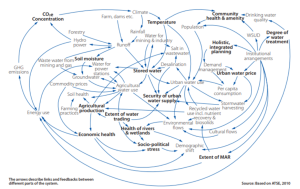
(Source: Interdependencies of water, the resource of life – ATSE)
Water scarcity and drought accountability
Also, worldwide, underprivileged communities often coexist with water-intensive industries like fracking, which aggravate droughts and pollute water resources, worsening the climate crisis. These areas face increasingly severe droughts due to rising atmospheric temperatures, mainly caused by CO2 and CH4 emissions from fossil fuel burning. Evidence overwhelmingly links these emissions to the fossil fuel industry, which has profited from this harmful practice while misleading the public about its impacts. Despite knowing the damage caused since the 1970s, these industries continue to promote fossil fuel dependency (Source: 350.org).
“Significant impacts on and risks to our water security are already evident,
and these risks will continue to escalate unless deep
and rapid reductions in global greenhouse gas pollution can be achieved.”
(Source: Climate Council)
Australia’s ability to ensure water security hinges on decisive climate change action, especially the swift elimination of fossil fuels. The threat of climate change looms over Australia, with the escalating frequency and intensity of droughts and floods presenting costly challenges that are set to intensify over time.
WA’s water streamflow (rainfall runoff into dams), for instance, has extremely declined and is predicted to continue to decline. Reliance on desalinated water is predicted to increase from currently 28% to 65% by 2035 (Source: Water Corporation: Perth water use and predictions)
Staying on the current path of high emissions carries immense and escalating risks. Without a focused and rapid response to climate change, both within Australia and worldwide, any short-term solutions to drought will prove ineffective in the long run. Immediate and sustained climate justice action centred on strengthening community water governance, ensuring equitable control and rights over water resources, and upholding Aboriginal rights are essential components of a comprehensive climate response (Source: Climate Council).
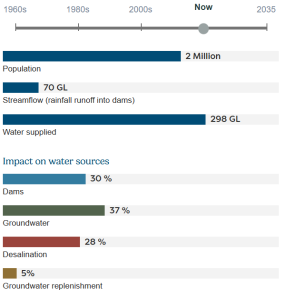
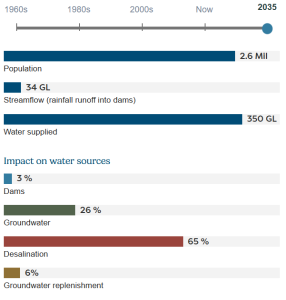
(Source: Water Corporation: Perth water use and predictions)
Read more:
Water shortages and worsening droughts
Water injustice runs deep in Australia. Fixing it means handing control to First Nations
Towards Water Justice – A ‘Statement from the Heart’
A tale of two rivers – Baaka and Martuwarra, Australia: Shared voices and art towards water justice
Read more about Indigenous Water Rights:
Indigenous governance, rights and access
Returning water rights to Aboriginal people
Closing the Gap: Water for People and Communities
2. Water advocacy
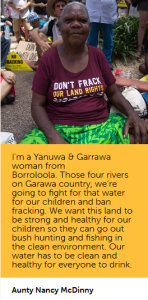
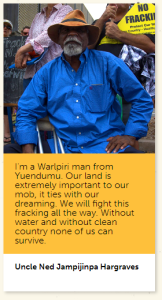
(Source: Seed Mob)
CSOs can help to strengthen Water Justice by engaging in Water Justice advocacy. Some of the projects below provide more insights to this.
“Martuwarra is an invaluable source of life and strength for our region’s culture and biodiversity.
Across the country all human beings should understand their role in protecting non-human beings as equals, not a resource.
We must wake up the consciousness of this country in the lead up to the
2022 federal election and let our government know that for human beings to thrive, all species must thrive.”
— MARLIKKA PERDRISAT
(Source: First Nations Water Rights and Activism)
Australian Youth Climate Coalition (AYCC)
The Australian Youth Climate Coalition (AYCC) campaigns against Tamboran Resources’ fracking in the Beetaloo Basin, Northern Territory, due to risks to water resources and sacred sites. Fracking could contaminate and deplete groundwater and harm waterways like Newcastle Creek and Lake Woods. The AYCC supports using the ‘water trigger’ in the Environment Protection and Biodiversity Conservation (EPBC) Act to ensure strict environmental oversight of such projects. Their advocacy seeks to protect water, ecosystems, and Indigenous cultural sites. For more details, visit Tamboran Fracking and Water Trigger.
Murray–Darling Basin Aboriginal Water Entitlements Program
In the Murray–Darling Basin, which is home to over 50 First Nations, water plays a crucial role in connecting communities to their land. However, colonisation has severely limited their access to water, with First Nations Peoples now owning less than 0.2 per cent of surface water entitlements. To address this, the Australian Government has launched the $100 million Murray–Darling Basin Aboriginal Water Entitlements Program. This initiative, part of a broader effort to strengthen the Water Amendment (Restoring Our Rivers) Act 2023, aims to enhance the cultural, social, economic, spiritual, and environmental well-being of First Nations Peoples. The program includes a strategic purchasing framework to guide the acquisition of water entitlements and has set up interim governance arrangements to ensure timely purchases. Ongoing consultations with First Nations communities are shaping the program’s design and governance to ensure the entitlements benefit these communities effectively.
Committee on Aboriginal and Torres Strait Islander Water Interests (CAWI)
The Committee on Aboriginal and Torres Strait Islander Water Interests (CAWI) is made up of water experts from all over the country. Members were selected for their expertise in water issues, not because of their specific Nation. They have a lot of experience and valuable connections thanks to their:
- understanding of water’s cultural significance
- knowledge of water policy, planning, management, and markets
- ability to work with Aboriginal and Torres Strait Islander communities.
You can subscribe to their updates or find out more by emailing: Contact CAWI at CAWI@dcceew.gov.au
Dja Dja Wurrung Clans call for water rights and a greater say in water management
The Dja Dja Wurrung Clans Aboriginal Corporation (DJAARA) has launched the ‘Dhelkunyangu Gatjin’ strategy, which means ‘working together to heal water’. This strategy calls for the Dja Dja Wurrung people to have a stronger voice in water management and access to water rights on their traditional lands in central Victoria.
Since colonisation, they have been excluded from decisions about water, making it hard for them to care for waterways and benefit from the water economy. Although their role in natural resource management, including water, was recognised in a 2013 agreement with the Victorian government, little progress has been made.
The strategy includes creating a Gatjin Authority to oversee water-related responsibilities and ensure their inclusion in Victoria’s water system. Organisations like Coliban Water and the Victorian government have welcomed the strategy, seeing it as a way to improve water management and heal Country.
3. Reducing organisational water use (Section for organisations with assets)
Step 1: Assemble a water reduction team
Involve team members, organise meetings, understand climate and water circumstances in your region, familiarise yourself with water reduction options and undertake the following steps collectively.
Step 2: Assess current water use and conduct a water audit.
Start by creating an inventory of all water use points in the facility. Walk through your premises, identifying every point in which water is used. For items such as toilets and tapware, the inventory should include the item’s location and flow rate. If the facility has low-flow fixtures or if flow restrictors have been installed, identify them on the inventory. To measure the flow rate, it may be necessary to use a stopwatch and a bucket to determine the actual water flow rate. Conduct a water monitor and irrigation test with the use of a template to detect water waste and leaks. You can also develop an organisation-specific Water Audit Form.
Your organisation’s benchmark provides a reference point against which water usage can be measured and compared, while continuous improvement actions, for example, teams or workshops, can stimulate innovation and adaptation.
Step 3: Develop a water reduction action plan
Based on your water audit, establish a water reduction and management plan.
Set goals and plan steps to reduce water waste. Check the Quick Tips section for more information.
Include:
- Leak detection and repairs
- Install low-flow fixtures
- Water-efficient technologies based on water rating labels
- Saving water in the toilet
- Conservation practices (indoor and outdoor)
- Rainwater harvesting
- Water reuse and recycling
- Revegetate garden with water-wise and native plants
- Create a bush tucker garden
Full Guides and Templates:
Water Management Plan Template, Department of Health Victori
Visual Guide: WELS and Water Ratings in Australia Explained (2023) – Buildmat
Step 4: Develop a water reduction and management policy
Develop a water reduction and management policy. Include your vision and commitment to assess and improve water-saving measures regularly.
Step 5: Monitor, repair and replace
Active monitoring practices to make water efficient are every employee’s responsibility. Integrate water efficiency messages and initiatives at staff meetings and in communications to enable active monitoring and encourage staff to report leaks. A toilet trickle can cumulatively waste around 9,000 L of water a year. Repairing a leak as soon as practicable and regular audits will assist your organisation in locating visible and invisible leaks.
Step 6: Training and continuous improvement
Water sustainability training offers a range of benefits. It promotes water resource conservation among staff, creates a Waterwise workplace and contributes to mitigating water scarcity. It enhances the organisation’s reputation and prompts long-term planning for efficient water use. Overall, integrating water sustainability training fosters responsible water management, cost savings, environmental consciousness, community engagement, and compliance and enhances your organisation’s reputation.
Step 7: Encourage collaboration and support water rejuvenation efforts
Foster partnerships with other community organisations, government agencies, and water experts to develop water management plans. Work together to implement sustainable water practices, monitor water usage, and address any emerging water-related challenges.
Participate in or facilitate initiatives that aim to rejuvenate local water bodies, such as rivers, lakes, and wetlands. Engage with community members in activities like tree planting, watershed restoration, and river clean-ups with the assistance of a community stewardship grant. By collaborating with various stakeholders, you can ensure a holistic approach to water management, spread awareness, and take collective action towards water conservation and restoration.
4. Quick Tips
- Install flow restrictors or aerators to tap wear and replace old inefficient showerheads for new water-efficient WELS 4-star rated models.
- Replace your reticulation controller with a weather-based irrigation controller.
- Use the half flush to save up to 65% water in Dual flush toilets.
- Plant native gardens Our A-Z guide to WA native plants | Water Corporation, WA
- Create your own bush tucker garden
- Use technology to access other organisations’ ideas. Saving water in the workplace – our recommendations for any business (livingwatersmart.com.au)
- Find more water-saving tips on the Water Corp website
- Use a car wash that recycles water to clean your fleet vehicles
Read more
Water Corporation WA. Hints, tips, and informative
Business water management – Water Corporation, WA, this resource provides guidance in assessing water usage and establishing a water reduction and management plan.
Check and integrate your organisational SDG Goal 6, Clean Water and Sanitation
United Nations – Department of Economic and Social Affairs: Sustainable Development Goals (SDGs), Goal 6 | Department of Economic and Social Affairs (un.org) Check, monitor and compare your water usage. Water Corporation: On this website, you can access information and tools to check, compare and monitor your water usage.
Create a waterwise workplace
Government of Queensland, in this resource, you will find guidance on increasing water usage awareness with staff, water efficiency management, and waterwise labels such as the Water Efficiency Labelling and Standards (WELS) scheme and Smart Approved WaterMark.
Measure the environmental impact of your organisational water use
Ture Impact, this resource provides tools to help assess your organisational water consumption and lists several actions that can be taken to reduce water use, including
Develop organisational water sustainability through analysis, assessment, goals and strategic planning
Global Environmental Management Initiative, this resource provides the following tools: Module 1: Water Use, Impact, and Source Assessment • Module 2: Business Risk Assessment • Module 3: Business Opportunity Assessment • Module 4: Strategic Direction and Goal Setting • Module 5: Strategy Development and Implementation
Set a goal to help focus attention on what needs to be done
Living Water Smart, this tool provides an overview and recommendations on several measures that can be put in place to identify and reduce organisational water use, including leaks, irrigation, education, setting targets and implications for board and staff involvement.
Check waterwise advice, updates and programs
Water Corporation, this website provides tips and advice on ways to save water in homes and offices, including change of habits, identification of waterwise plants and waterwise building programs.
Improve water efficiency in the most cost-effective and immediate way
Department of Water and Environmental Regulation, this resource contains a toolkit promoting water efficiency and water recycling.
Develop and implement an organisational water conservation policy
Legal Assistance Centre, this resource contains a Template Workplace Water policy in an example developed in and for Namibia. It includes a description of workplace responsibilities related to water conservation and lists policy elements that help to become a water-efficient workplace.
Organisational water footprint
Organisational water footprint: methodological guidance, this academic resource proposes a practical methodological approach to assess the water footprint at the organisational level, in line with the current development of life-cycle-based approaches toward the organisational scale on the one hand and footprint metrics on the other hand.
WaterPub – Data and Publication – Water Footprint Network, WaterPub is the world’s largest repository of water footprint publications. It includes peer-reviewed papers as well as books, reports, datasets, and the Global Standard WFA Manual.
Audit resources
